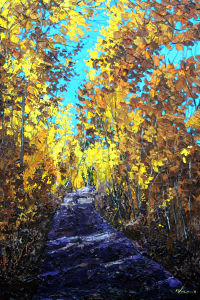Raines Grove: Difference between revisions
Giles Sednik (talk | contribs) No edit summary |
Giles Sednik (talk | contribs) |
||
| (One intermediate revision by the same user not shown) | |||
| Line 14: | Line 14: | ||
==Raines Grove== | ==Raines Grove== | ||
[[Image:Autumn walk.jpg|200px]] | |||
===Description=== | ===Description=== | ||
''"...Where the pale tendrils of autumn stretch<br> | ''"...Where the pale tendrils of autumn stretch<br> | ||
| Line 24: | Line 25: | ||
===History=== | ===History=== | ||
In 1998, the Eastern-most edge of [[Ryse Place]] (connecting with [[Fyfhyde Plaza]]) was renamed in honour of J.M. Raines, the "lost beatnik", who wrote the famous "Donnie Larkum" verse in the area now known as Raines Grove. | In 1998, the Eastern-most edge of [[Ryse Place]] (connecting with [[Fyfhyde Plaza]]) was renamed in honour of J.M. Raines, the "lost beatnik", who wrote the famous "Donnie Larkum" verse in the area now known as Raines Grove. | ||
Jennifer | |||
Jennifer Renee Raines is a disputed beatnik poet, one of only a handful of women poets and non-Americans associated with the movement, who wrote under the nom de plume J.M. Raines. Her work was largely ignored at the time of her prolificacy, but since her untimely death it has been rediscovered. | |||
While the writing of Raines bears many similarities to that of Keroac's "beat-generation", Raines likely developed her style in isolation and separately from the American movement. As such, her status as a beatnik poet is currently disputed, since the definition has typically been reserved to describe a small handful of writers and their associates, among whom Raines was not counted as a member. | |||
Regardless of her status as a beatnik, her writing has generated an enormous amount of interest within the last 20 years, challenging our assumptions about the beatnik movement and our understanding of history. A few tattered copies of "Foulkesian, Still Swearing" can still be salvaged from the remains of the [[Naisbitt Library]]. | |||
<br style='clear: both' /> | <br style='clear: both' /> | ||
---- | ---- | ||
[[Category:Streets]] | [[Category:Streets]] | ||
[[Category:Foulkes Village]] | [[Category:Foulkes Village]] | ||
Latest revision as of 19:55, 13 January 2010
| Raines Grove
Foulkes Village [4, 81]
Basic Info:
|
Raines Grove
Description
"...Where the pale tendrils of autumn stretch
out bony sprigs and
fiery snares uncoil to the kiss of sun
the grove
is humming Donnie Larkum spiritual hash smoking smiling naked..."
Excerpt from "Foulkesian, Still Swearing" by J.M. Raines.
History
In 1998, the Eastern-most edge of Ryse Place (connecting with Fyfhyde Plaza) was renamed in honour of J.M. Raines, the "lost beatnik", who wrote the famous "Donnie Larkum" verse in the area now known as Raines Grove.
Jennifer Renee Raines is a disputed beatnik poet, one of only a handful of women poets and non-Americans associated with the movement, who wrote under the nom de plume J.M. Raines. Her work was largely ignored at the time of her prolificacy, but since her untimely death it has been rediscovered.
While the writing of Raines bears many similarities to that of Keroac's "beat-generation", Raines likely developed her style in isolation and separately from the American movement. As such, her status as a beatnik poet is currently disputed, since the definition has typically been reserved to describe a small handful of writers and their associates, among whom Raines was not counted as a member.
Regardless of her status as a beatnik, her writing has generated an enormous amount of interest within the last 20 years, challenging our assumptions about the beatnik movement and our understanding of history. A few tattered copies of "Foulkesian, Still Swearing" can still be salvaged from the remains of the Naisbitt Library.
